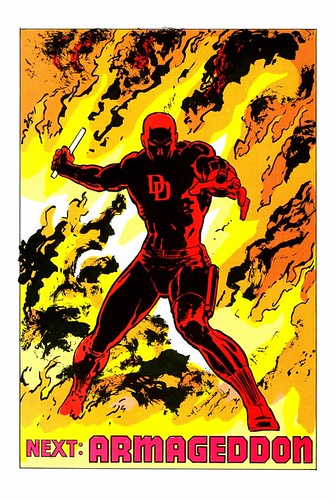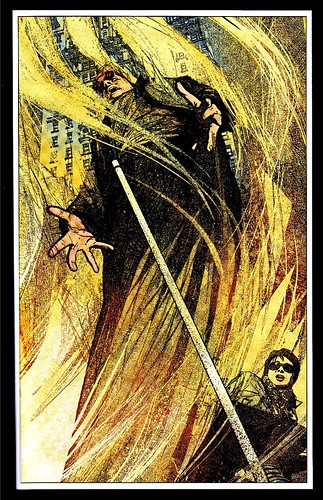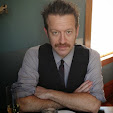
The Comics Reporter has posted an interesting look at the state of comics scripting in mainstream comics, an article of some depth written by Ng Suat Tong. If you click over, fair warning: you may be annoyed, as I was, that the script examples were not big enough to read, and then more frustrated when you discover a button at the bottom of the page, after you've read the whole thing, linking to bigger versions of the files--which are presented out of order and so large as to go right off the screen. Oy vey.
I also had some follow-up thoughts regarding a couple of the points made in the article, which is not a piece I am endorsing as something I agree with entirely, but rather an interesting beginning point for discussion. I do think the writing process and the collaborative process should be discussed more, and I do agree that the writer's name being bigger than the rest is unfair and downright wrong. On the other hand, I specifically felt there was a failing in the representation of Brian Michael Bendis, and I sent the following note to the blog.
Tom -
Ng Suat Tong's survey of mainstream writers and their approach to scripting made for interesting reading, but I think there are two things in regard to Brian Michael Bendis that should be noted. One is an observation, the other a correction of sorts.
1. It seems any meaningful look at Brian's work should have taken into account that he is an artist himself, and though he has all but abandoned cartooning since, by his own admission, draftsmanship was not his strength, one can clearly see a continuity between how he told a story on his own and how he does so in collaboration. While Brian's scripts can be sparse, his role as someone who thinks visually about page construction should not be diminished. Arguably, his arrangement of dialogue from panel to panel, page to page, has been one of the most influential developments in the last ten years or so.
2. In regards to the Daredevil Omnibus, I am pretty sure the image being shown on your site is the dust jacket cover prior to a replacement version being reprinted. The initial shipment had a (c) symbol smack dab in the middle of Daredevil's face, and when Marvel printed loose, corrected versions to ship to customers, Bendis demanded they change the cover copy to include not just the artists, but I believe the colorist, as well. Mr. Tong suggests that Bendis would not likely support such a divide, implied or otherwise, between the importance of the contributors, and that is indeed correct.
___
Jamie S. Rich

I guess I shouldn't be surprised that this topic should come up, since the #1 question promoting You Have Killed Me
Truthfully, if I may be permitted to go slightly off the path, I think the idea of the superstar writer is far less pervasive than is often suggested. There are, sure, a handful of guys that get promoted up top, but I find in this age of the cartoonist, there is actually a strange mistrust of collaboration. Despite the classic comic model being one of team effort, there has been this elevation of the "one guy does it all" concept that I think has often been detrimental to some talented people who rush to do it all when maybe they shouldn't. As a writer, I know better than to try to draw; there are many artists who can't say the same about writing. It should be about what best serves the story, not about what best serves someone's reputation or the consensus of wags on the internet as to what constitutes more important works. (The hive mind amongst the readership also points to a certain dour mini-genre of cartoonist-driven comics, which should no more be the full representation of comics than the capes and tights.) There is no one way to script, just as there is no one way to outline your panel borders or one font to letter. It's all different.
Though a cinematic reference will likely be poo-pooed, I am reminded of a famous Orson Welles quote that is often used to counter the auteur theory of moviemaking: "A writer needs a pen, an artist needs a brush, but a filmmaker needs an army." This statement is actually quite appropriate if we link it to the similar proliferation of the auteur theory in comics. If anything, the greater reverence for the cartoonist has inspired a stronger sense of collaboration in the trenches, and if writers have pulled back on the descriptions in their scripts, it's because they have a greater trust in the people they are working with, not because anyone thinks they are superstars. There is a greater respect on each side for what each contributor does best.
In the back of the recent reprints of The Amazon
And effective communication is what all writing is about anyway.
Then again, these days we can also go the opposite. Apparently 140 characters or a Facebook window is supposed to be the ideal length for expressing a thought; yet, I couldn't even fit my first paragraph of this essay on my Facebook profile, and so instead of posting a simple link with a tiny explanation about the images in that link, I came here to have a little more room, and look what the hell happened!
Current Soundtrack: Ian Brown, Solarized
e-mail = golightly at confessions123.com * Criterion Confessions * Live Journal Syndication * ComicSpace * Last FM * GoodReads * The Blog Roll [old version] * DVDTalk reviews * My Books On Amazon
All text (c) 2009 Jamie S. Rich


5 comments:
Yeah, I found the article quite interesting, but I certainly didn't agree with many of the writers points. I love good cinema, but not sure why comics are suddenly better when they're deemed "cinematic"---so I'm in agreement with the editorial there, if I understood it correctly. But why's Alan Moore the standard by which all scripts are measured? I understand we're talking mainstream comics here, but...ichh.
I think the cinematic comparisons came out of a sense of greater dynamism that emerged once artists started really breaking out of the grid, as well as what is really a more manga-like technique of spending longer time on specific moments. I see when artists are particularly trying to create a sensation of movement where the inspiration comes in, but I agree, it shouldn't be considered a technique that is inherently better or improves the medium just by gracing us with its presence. :)
I must say, I particularly loathe the adoption of terminology from television and movies, giving us things like "seasons" of comics and "director's cuts." There was also the "widescreen" format. We shouldn't ignore the fact that it's the movies that rip us off the most and need our product for adaptation, not the other way around.
There were a lot of points in that article with which I had problems. There wasn't really a sense of history to it, as in, the '80s and '90s were extremely artist-centric, so perhaps this current cult of the writer is more of a cyclical thing, or maybe there just aren't as many distinctive superhero/genre artists these days. I think it's also worth noting that not only, as you said, is Bendis an artist himself, but that by the time of the issues sampled by Tong, he had been working with Maleev for some time, both on DD and Sam & Twitch. Naturally, once you have a regular collaborator, you get into a comfort zone where you don't have to explain everything and trust that the artist will either give you what you want, or maybe something better.
Tong really dismissed the Bendis/Maleev run on Daredevil as a regurgitation of what Miller/Janson did, but without details. I see similarities in the tone of the book but that's about it. Also, it was a shame he went out of his way to slame Brubaker's work if he wasn't going to provide reasons why he didn't like it.
Excellent points, Chris. I think there is actually a good idea in this article, it would be neat to see a real study of how different writers and artists work together. Matt Wagner, for instance, is an interesting example in that he does a more old school "Marvel style" plot when working with other artists, and works out most of the dialogue after. His reasoning is if we was going to go full script and break it down, he might as well draw it.
When the Bendis and Maleev issues were coming out, Daredevil was my favorite monthly comic.
Sean T. Collins didn't like this essay, either.
Post a Comment